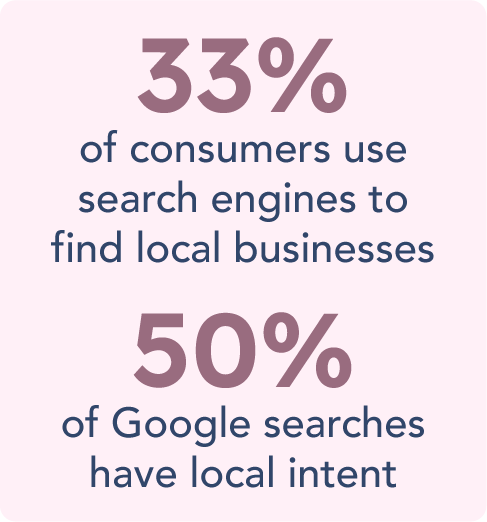Contemporary digital trends may not seem as important for a traditional vocation such as healthcare. Yet, even long-established professions, like healthcare, are now embracing digital platforms for engaging with their patient base. This engagement is never a one-way street and to benefit from it, you need to provide accurate information and actively follow patients’ online behavior.
Listing management and reputation management in healthcare have become foundations of providers’ online presence and credibility in the online world. Both are essential for healthcare businesses looking to adequately promote their practice and improve their image. Listing management helps raise and keep your online visibility, while the role of reputation management is to establish a desired public perception of your practice.
These two practices are often interconnected (and, unfortunately, often overlooked and underestimated in the healthcare community). The greatest examples are Google Business Profile (GBP) and Apple Business Connect (ABC). These tools often serve as the first digital stop for users, and hold multiple functions: they put you on the map (quite literally), provide key information about your business, and showcase other people’s experiences and impressions. It’s also worth looking into specialized healthcare review platforms, like ZogDocs, HealthGrades, or Vitals. Even though they’re not used as primary search engines (such as Google, Google Maps, and Apple Maps), they can still make a significant impact on your online reputation.
Although listing management and reputation management in healthcare are often inextricably related, they have distinct purposes and come with different operational requirements. Understanding these differences will help you make both of those concepts work simultaneously in your favor.
Listing Management In Healthcare – The Influence of Accuracy
Getting the wrong phone number or address from Google probably happened to you more than once. Well, it isn’t Google’s fault.
Simply put, listing management is the process of keeping your company’s information accurate and up-to-date across digital platforms. This includes key details such as your NAP (name, address, and phone number), office hours, services offered, etc. Its purpose is to enhance your visibility, elevate search rankings, and prevent patient dissatisfaction resulting from incorrect information.
 Listing management is crucial for your local Search Engine Optimization (SEO). Considering that 33% of consumers use search engines to find local businesses and 50% of Google searches have local intent, then listing management in healthcare is the way to become the first choice for patients in your community. But, that’s not possible without regular maintenance of your online information.
Listing management is crucial for your local Search Engine Optimization (SEO). Considering that 33% of consumers use search engines to find local businesses and 50% of Google searches have local intent, then listing management in healthcare is the way to become the first choice for patients in your community. But, that’s not possible without regular maintenance of your online information.
The quest for new patients heavily depends on the accuracy of your online information. Imagine a patient searching for your practice, only to bump into a wrong NAP, for example. What’s the purpose of your practice if those who need you can’t easily reach you?
Keeping Up With Listing Management In Healthcare
The main goal of listing management in healthcare is providing patients with correct information on the internet, making you visible in online searches and avoiding false data about your practice.
You can reach this goal by following several simple yet important strategic routines:
Consistency: Different Places, Same Information
Ensuring consistent information across various platforms is a key piece of your practice’s online success. Inconsistencies in your details can confuse users and signal search engines that your information might be unreliable, potentially affecting your ranking.
Consistent practice listings across the internet sends a message of reliability and helps in optimizing your local SEO. However, each platform has unique guidelines and formatting requirements, such as the number of characters to describe your practice. So, to properly use listing management in healthcare, get familiar with those rules and prepare the information you want to provide beforehand.
Coverage: Get Easily Found
One of the perks of the digital era is the ability to be in different places at the same time. Missing that opportunity could leave you in the shadows, risking decline in both your practice volume and income.
Merely placing information on your website isn’t enough for listing management in healthcare, as Google cross-references data across different directories. To maximize visibility and connect with a broader patient community, list your healthcare practice on all major search engines, healthcare directories, and social media platforms.
Your listing strategy, including the selection of platforms, should be part of your healthcare marketing plan, considering factors like location, target audience, and the nature of your services. For example, you won’t target older patients on TikTok or present your dental services on an online platform for orthopedic injuries. For more accurate coverage, your listings must be optimized.
Updates: Every Change Matters For Listing Management In Healthcare
 It may sound trivial, but overlooking even the smallest update about your practice can cause negative consequences, demanding a significant use of your resources for mitigation. Imagine you level up your business from a small office to the best polyclinic in town, but forget to mention this update in your listings. This would undoubtedly result in slow growth and unwanted expenses.
It may sound trivial, but overlooking even the smallest update about your practice can cause negative consequences, demanding a significant use of your resources for mitigation. Imagine you level up your business from a small office to the best polyclinic in town, but forget to mention this update in your listings. This would undoubtedly result in slow growth and unwanted expenses.
The point of listing management in healthcare is to prevent these scenarios. Just as in any other profession, changes in healthcare are inevitable, whether in the form of new services, changed office hours, or relocations. Keeping your online presence up-to-date earns patients’ trust and keeps your door open.
Reputation Management in Healthcare – Nurturing Trust
Reputation management is all about perception. It requires constant awareness of how an organization is seen by their audience, especially online. Reputation management is especially important in healthcare as it helps track, analyze, and influence patients’ trust in your practice. This can be achieved by managing patient reviews, addressing concerns, highlighting positive feedback, and favorably presenting your healthcare organization.
By the nature of its use, reputation management can be proactive and reactive. A proactive approach focuses on building and sustaining a positive reputation and usually involves strategic efforts intended for promotion, such as online marketing campaigns. A reactive approach comes into play when addressing negative PR, aiming to minimize unfavorable consequences.
In both cases, actively building your online image strengthens the trust and credibility among patients, fostering loyalty and a positive voice about your practice. However, the point is to recognize and avoid common mistakes providers make when using reputation management in healthcare, so you can align your public image with precisely planned strategies.
How To Navigate Reputation Management In Healthcare
Influencing patients’ perception of your practice brings together strategic actions, content creation, and damage control measures, protecting your image in the eyes of the patients.
Since reputation management in healthcare serves as an effective way to attract patients, it’s important to include its key elements in every step you take.
Managing Feedback – Be Responsive
Frequently reviewing feedback on online platforms offers valuable insights into patient perception and areas for improvement. Positive mentions are always welcome and have a motivational effect, but negative comments should never be ignored.
Addressing both positive and negative feedback shows a proactive approach to patient concerns. Expressing gratitude for positive reviews while showing empathy for the concerns of dissatisfied patients is a significant component of effective reputation management in healthcare. The most important step in overcoming the fear of negative reviews is to see them as an opportunity to regroup and grow, while always responding in compliance with HIPAA rules.
Promotional Activities – Show The Success
While it’s said that success can never be hidden, giving it a little strategic nudge can’t hurt.
Showcasing patient success stories, awards, accreditations, and positive testimonials enables you to effectively manage your reputation and position yourself as a reliable and patient-focused practice. Your overall reputation in the healthcare sector will notably increase through a consistent projection of a positive image through diverse promotional channels.
For example, using social media as a part of reputation management in healthcare is an excellent way to connect with a broad audience. Social media offers a platform for you to educate your audience and share your skills. It can also be a great source of authentic patient testimonials, which can enhance your reputation and build your network.
Tracking – Get Real Insights into Your Patients’ Behaviour
We’re living in a time where every online activity can be precisely monitored. For healthcare providers, this is an opportunity to get insights into their patients’ habits, reactions, and inquiries.
By actively tracking activities, such as social media metrics, website analytics, or marketing campaign monitoring you can identify areas for improvement, respond to issues promptly, and highlight positive aspects of your services. Ultimately, this proactive approach contributes to building and maintaining a positive reputation in the healthcare industry.
Learn The Difference, Take The Advantage
While both listing and reputation management play an important role in healthcare’s digital presence, they ultimately fulfill distinct purposes.
As we’ve seen, listing management in healthcare deals with the specific aspects of your online presence, enabling easy patient access and reliable information. On the other side, reputation management relies on perception—capturing patient experiences, provider responses, and the collective impact of your engagement.

To easily distinguish these two concepts, just remember these simple associations: listing management refers to business information, whereas reputation management refers to online reviews. Listing management ensures your business details are accurate and consistent, which is crucial for patients to find and contact you. Reputation management focuses on monitoring and improving how patients perceive your practice through reviews and feedback.
Both elements are crucial to establishing credibility and attracting new patients. Accurate listings support a positive reputation by making it easier for patients to access your services, while positive reviews validate the quality of your care.
To maintain a sharp online image, you should understand and apply best practices for both listing and reputation management.
Listing Management And Reputation Management In Healthcare – The Power Of Dual Approach
For healthcare providers looking to make a strong online presence, the combination of listing and reputation management in healthcare is now non-negotiable. It can sound like a lot to deal with, but implementing these two concepts in your healthcare marketing plans results in enhanced reputation and better patient acquisition.
SocialClimb’s comprehensive healthcare marketing platform can automate these two distinctive concepts to work together for the benefit of your profession. Managing all your listings over a single platform is a practical way to always stay up-to-date and lower the risk of dissatisfaction caused by incorrect information while saving precious time. With reputation management features, your public image stays sharp and clear, without adding more items to your to-do list. What’s more, your patients’ behavior insights come as generated reports, helping you to be aware of what to improve. Being instantly notified about negative reviews gives you a chance to mitigate negative consequences, and you can engage with your patients across different platforms from one location. Our team will simplify the process so that you can easily enjoy the benefits of listing and reputation management.











